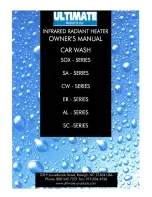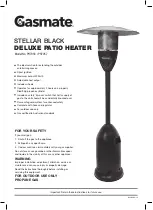
8. In the event of long-lasting heavy smoke development, unusual combustion noises or a
smell of fuel or if the heater suffers continuous fault cut-outs with error messages (flash-
ing code), it must be shut down by removing the fuse and must not be reused until it has
been inspected by Webasto-trained personnel.
9. Wherever inflammable vapours or dust may form (for example in the vicinity of
fuel, carbon, wood dust or cereal stores or the like), the heater must be switched
off as a result of the risk of explosion.
10. The heat transfer unit on air heaters is exposed to very high thermal stress and
must be replaced by a genuine Webasto spare part ten years after it is used for
the first time.
If exhaust lines pass through areas used by personnel, they must also be replaced
by genuine spare parts after ten years.
11. The fuel specified by the vehicle manufacturer is suitable for use in the Air Top 2000 ST
B (petrol EN228).
The diesel fuel specified by the vehicle manufacturer is suitable for use in the Air Top 2000
ST D (diesel EN590).
We know of no negative influences due to additives.
If fuel is extracted from the vehicle’s tank, follow the additive instructions issued by the
vehicle manufacturer.
If you change to low-temperature fuel, the heater must be operated for approx. 15 min-
utes so that the fuel system is filled with the new fuel.
12. The temperature in the area around the heater must not exceed 85 °C (storage temper-
ature). If the temperature exceeds this level there is a risk of permanent damage to the
electronics systems.
13. Non-compliance with the installation instructions and the warnings contained therein will
lead to the exclusion of all liability by Webasto. The same applies if repairs are carried out
incorrectly or with the use of parts other than genuine spare parts. This will result in the
invalidation of the type approval for the heater unit, and therefore of its homologation/
EC type licence.
14. Keep the hot air inlet and hot air outlet free of dirt and foreign bodies. Soiled or blocked
hot air lines may cause overheating, and therefore result in the overheating cut-out trip-
ping.
15. To prevent mechanical parts seizing, the heater should be operated for approx. 10 min-
utes every four weeks.
16. Do not stand on the heater and do not place any heavy items on the heater or throw
items at the heater.
17. Do not place any items of clothing, textiles or similar materials over the heater or in front
of the hot air inlet and the hot air outlet.
18. The current of hot air in the heater must not be restricted or blocked by highly inflamma-
ble substances or materials such as rags, cleaning wool, etc.
19. The heater must not be cleaned with a high pressure cleaner.
Visit www.butlertechnik.com for more technical information and downloads.
www.butlertechnik.com


























